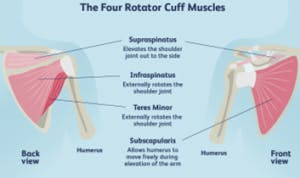
Understanding the Rotator Cuff
By Rebecca McVay PT, DPT
The Rotator Cuff is the collective name of the four muscles on your shoulder blade that form a tendon that attaches to your upper arm to help to lift and rotate your arm. There is a bursa sac between the rotator cuff and the bone on top of the shoulder known as the Acromion that allows the rotator cuff tendons to glide freely when you move your arm.
When the rotator cuff tendons are injured or damaged, this bursa can also become inflamed and painful. An injury to the Rotator Cuff can occur two ways.
A Traumatic tear can occur when you fall on an outstretched arm or lift something too heavy for your arm.
A Degenerative tear usually occurs with repetitive motions and is usually result of wearing down of the tendon that occurs slowly over time. This can be caused by repetitive overhead sports like baseball, tennis as well as many jobs that require repetitive motions.
Poor posture is a very big contributor to Rotator Cuff injuries. Rotator cuff tears are more common in the dominant arm.
Symptoms of a Rotator Cuff injury include:
• Pain at rest and at night, particularly if lying on the affected shoulder
• Pain when lifting and lowering your arm or with specific movements
• Weakness when lifting or rotating your arm
• Crepitus, or a crackling sensation, when moving your shoulder in certain positions
Physical therapy can help treat many Rotator Cuff injuries. A PT can thoroughly evaluate your shoulder, neck and upper back to help determine a good treatment plan for you and recommend a follow up with your doctor if needed.
4 Common Misconceptions of the Rotator Cuff
1. Rotator Cuff tears are uncommon
There can be some confusion with other shoulder injuries like tendonitis or bursitis, but rotator cuff tears or partial tears are very common, affecting millions of Americans each year. Though a tear can happen to anyone, individuals who are older (40+) or who compete in sports or work jobs that require repetitive shoulder use are more likely to experience a rotator cuff tear.
2. An MRI is needed to diagnose a Rotator Cuff injury
Although a useful diagnostic tool in healthcare, an MRI can be costly and are not always necessary for diagnosis. A thorough physical therapy exam can be used to diagnose a Rotator Cuff injury through functional movement screens that test your shoulder’s strength and range of motion.
3. I need surgery to fix a Rotator Cuff injury
A good physical therapy program is often a great first step to treating your Rotator Cuff injury, to help heal the tissue, restore your range of motion, and regain strength, while providing you with other exercises to help prevent additional future injury. Surgery may be recommended if the rotator cuff is completely torn, or pain persists after 6-8 weeks of physical therapy.
4. Exercise makes Rotator Cuff injuries worse
While some activities that continue to add load or stress on the shoulder can worsen your symptoms, you do not have to take a break from exercise altogether, just need to perform the right ones, and safely. Some exercises help strengthen your shoulder girdle and help relieve rotator cuff pain. Your Flaherty Physical Therapist can prescribe an exercise routine that will be specific to your needs, and help to recover safely while still remaining active.
Remember to always reach out to your favorite Physical Therapist to get some guidance with your shoulder pain!


